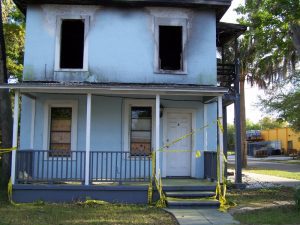
(c) Canstock Photo
Meth Lab houses can be found almost anywhere in Oregon. The process required to manufacture meth is easy, with the raw materials necessary for its production readily available to the public. Recipes and information for the manufacture of the drug are found on the Internet. By investing just a few hundred dollars in equipment and chemicals, a home manufacturer can produce a finished product worth thousands of dollars.
Ingredients to make meth can be purchased in any drug, grocery, or hardware store. Some commonly used ingredients are over-the-counter cold and asthma medications containing ephedrine or pseudoephedrine; red phosphorous; hydrochloric acid; drain cleaner; battery acid from lithium type batteries; lye; acetone; lighter fluid; lantern fuel; and antifreeze.
If meth has been manufactured on a property, health issues resulting from occupying or just entering the property could be severe. Each pound of produced meth leaves behind five or six pounds of toxic waste. Meth cooks pour leftover chemicals and byproduct sludge down drains and nearby plumbing, storm drains, or directly on the ground. Chlorinated solvents and other toxic byproducts used for making meth pose long-term hazards because they can persist in the soil and groundwater. Clean-up costs are high because solvent-laced soil usually has to be incinerated.
Meth houses are enveloped in an unpleasant, chemical-like ammonia smell, similar to cat urine or fingernail polish. In addition to the smell, there are other signs that a house is used as a meth lab. Another sign would be chemical drums or other containers about the property that store solvents, drain cleaner, or antifreeze. Most people entering a meth house will experience immediate eye and throat irritation, lightheadedness, or headaches. Acute short-term exposure to high concentrations of some of the chemicals used in meth production, similar to what law enforcement officers often face, can cause severe health problems, including lung damage and burns to different parts of the body.
Meth lab houses require special attention
Oregon has a comprehensive program to identify and deal with contaminated drug properties. Oregon’s law for contaminated drug houses is outlined in ORS 453.855 through 453.912. The law does not allow a contaminated property to be occupied and provides procedures for proper cleanup and certification of fitness after cleanup has occurred. The main provisions of the law are:
- Identifying a property as not fit for use – The Director of Human Services, the State Fire Marshal, or any law enforcement agency may make the not-fit-for-use determination. Once determined, the property may not be entered, occupied, or used for any purpose. This means that the owner may not enter the property for cleaning, remodeling, or demolition except under a Department of Human Services approved work plan. To be considered suitable for use, the property must be successfully certified as decontaminated. In some cases, the structure on the property may have to be demolished, and any ground contamination will have to be cleaned up before being certified. Once determined to be contaminated property, the property is listed as such with the Department of Consumer and Business Services.
- Restriction on transfer of a contaminated property – ORS 453.867 prohibits the transfer, sale, use, or renting of any property determined to be an illegal drug manufacturing site. All contracts to transfer, sell, use, or rent a contaminated property are voidable between the parties at the purchaser’s request, transferee, user, or renter. Under ORS 453.870, contaminated property may be transferred or sold only if full written disclosure is made to the prospective purchaser of the contamination status. After the transfer, the property remains as contaminated property and may not be entered, used, or occupied.
- Property decontamination – The owner of a property determined to be not fit for use may have the property certified as fit for use. To be classified as a property fit for use, the owner must engage a contractor licensed by the Department of Human Services (DHS) to decontaminate the property. The decontamination work must be executed by a written work plan submitted to DHS for approval. If the work plan is approved and the decontamination work is completed according to the plan, the DHS will certify the property as decontaminated. Once the DHS has certified the property as decontaminated, the property owner shall notify the Department of Consumer and Business Services and request that the property is removed from the department’s list of contaminated properties. Once the property has been taken off the contamination list, the property may be transferred, sold, used, or rented without restriction.
The safest way to clean up a former meth lab is to hire an environmental company trained in hazardous substance removal and cleanup. If the owner of the property desires to do the cleanup, extreme caution should be exercised because the contaminants give off fumes, penetrate the skin, and result in severe health problems. The following are steps that would be taken by an environmental hazard cleanup company:
- Air out the property – The first step is usually a short-term airing-out of the property to clear out as many contaminants in the air as possible. This process should last several days before actual site cleaning.
- Heating structure and reintroducing ventilation – After the initial airing-out, the windows and doors should be closed, and the temperature inside the structure should be raised to approximately 90 degrees and left alone for a few days. This will promote some of the chemicals to volatilize (to dissolve into the air). After the heating process is complete, the structure is ready for cleaning. During the cleaning process, proper ventilation should again be introduced. After the cleaning process, the property should be aired out for three to five days to allow for any remaining volatilization of chemicals. Exhaust fans should be used to assist in this process.
- Contamination removal and disposal – The meth manufacturing process produces vapors that are absorbed into the material within the structure. Spilled chemicals, supplies, and equipment can further contaminate non-lab items such as carpeting, wall material, counters, cabinets, etc. Items that are visibly contaminated should be removed and disposed of in a landfill. Absorbent materials such as carpeting, drapes, clothing, and like material should also be removed from the property and disposed of in a landfill.
- Surfaces – Walls, counters, floors, ceilings, and similar surfaces are porous and can absorb contaminants from the meth manufacturing process. The closer to the actual location of the manufacturing, the more likely these materials will have absorbed the contaminants. If these surfaces have visible staining or contamination, these should be removed and disposed of in an approved landfill. In many cases, this may entail the removal and replacement of wallboard and similar surfaces. In some cases, intensive cleaning followed by applying a physical barrier, such as paint sealant or epoxy, may be an adequate solution.
- Ventilation system – Fumes from the meth manufacturing process will enter the structure’s ventilation systems. These systems must be thoroughly cleaned. This cleaning would necessarily include the vents, ductwork, filters, walls, and ceilings near ventilation ducts.
- Plumbing – Most meth cooks will dump their manufacturing byproducts down sinks, drains, and toilets. These contaminated waste products can collect in drains, traps, and septic tanks and give off harmful fumes. Drain traps and adjacent plumbing pipes may have to be removed and cleaned. In some cases, replacement may be necessary. The septic tank may have to be pumped and treated as a hazardous waste site.
- Repainting – It is advisable to repaint the entire interior of the structure. This will assist in putting a barrier between any residual contamination and the structure’s interior. Paint-coating materials specifically designed to seal in contaminants, such as products containing a shellac base, should be considered.
- Testing – Both before and after cleanup, the environmental cleanup company will test for contamination. Before cleanup, the test will identify areas where cleanup or removal of materials will be necessary. After the cleanup process has been completed, the test will verify that the structure is again suitable for occupancy.
The outlined cleanup process usually takes six to eight weeks, with a cost ranging from $5,000 to $25,000. Insurance coverage for drug house contamination might be possible but is reported to be available in only 25% of existing policies.
Under Oregon’s seller’s property disclosure statement law, an Oregon property owner is to disclose if the house being sold was ever used for manufacturing methamphetamine or any other illegal drug.
###
For more information about OnlineEd and their education for real estate brokers, principal brokers, property managers, and mortgage brokers, visit www.OnlineEd.com.

